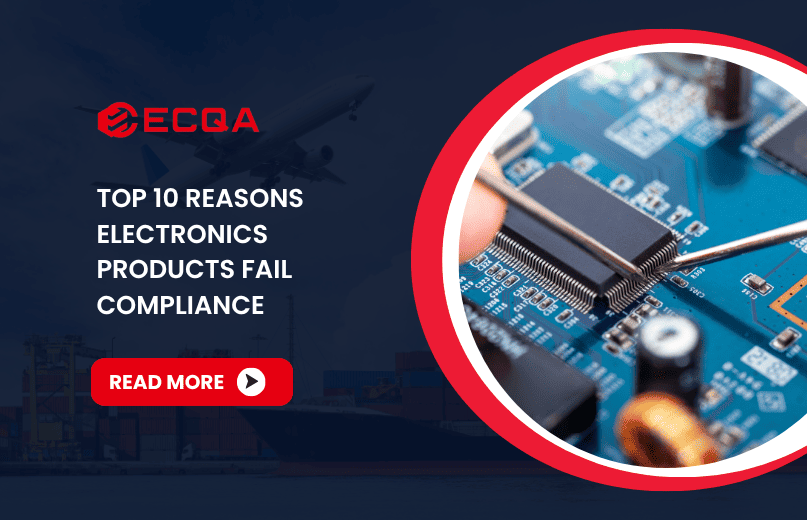
Top 10 Reasons Electronics Products Fail Compliance
Electronics compliance failures occur when products do not meet international safety, environmental, or certification requirements. Every charger, circuit board, and battery shipped across borders must satisfy strict rules such as CE marking, RoHS substance restrictions, REACH chemical disclosure, EMC standards, and country specific certifications.

A single mistake can result in blocked shipments, product recalls, or permanent market exclusion. These failures are not random. They usually stem from predictable issues such as incomplete documentation, improper labeling, weak testing, or ignoring market specific rules. By understanding the top reasons electronics fail compliance, exporters can build stronger systems and avoid costly risks.
Why Electronics Products Fail Compliance Checks
Electronics exporters often fail compliance checks because they lack updated documentation, use non compliant materials, or skip required testing. Common mistakes include missing CE declarations, RoHS violations, unsafe chargers, or ignoring certifications such as CCC, PSE, and SASO.
Top 10 reasons electronics products fail compliance
The following sections explain the top 10 reasons electronics products fail compliance and how exporters can prevent them.
CE Marking Compliance Failures
Common CE Marking Mistakes
The CE mark is mandatory for most electronics sold in the European Economic Area. Failures occur when:
- The CE mark is applied without a conformity assessment.
- The logo is distorted, resized incorrectly, or misplaced.
- The required Declaration of Conformity (DoC) is missing or incomplete.
Example Case
Many small appliance shipments are detained in European ports because factories applied the CE logo without valid testing or documentation.
How to Prevent
- Complete the conformity assessment process.
- List the correct directives, such as the Low Voltage Directive 2014/35/EU and EMC Directive 2014/30/EU.
RoHS Compliance Failures
Hazardous Substance Restrictions
The RoHS Directive restricts hazardous substances such as lead, cadmium, mercury, and brominated flame retardants in electronics.
Typical Failure Causes
- Factories using lead based solder without proper testing.
- Components purchased from unverified suppliers.
- Reliance on expired or incomplete RoHS certificates.
How to Prevent
- Conduct periodic material testing in accredited labs.
- Collect standardized IEC 62474 material declarations from all suppliers.
- Monitor high risk components such as cables, plastics, and solders.
REACH SVHC Non Compliance
Disclosure Requirements
The REACH Regulation requires companies to disclose and, in some cases, register substances of very high concern (SVHCs) present above 0.1% weight by weight.
Common Violations
- Plastic housings containing brominated flame retardants not checked against updated SVHC lists.
- Failure to notify customers when SVHCs are present in cables or batteries.
Example Case
Customs in Belgium confiscated USB cables containing high levels of phthalates. The supplier could not prove that customers had been informed.
How to Prevent
- Update SVHC screening every time the European Chemicals Agency publishes its biannual updates.
- Maintain current Safety Data Sheets (SDS).
- Train suppliers to check materials against updated SVHC lists.
EMC Compliance Failures
EMC Testing Requirements
The EMC Directive in the EU and FCC rules in the US ensure electronics do not cause electromagnetic interference and can operate safely.
Frequent EMC Issues
- Launching products without EMC pre compliance testing.
- Using low cost shielding materials.
- Incorrect labeling that omits FCC ID or EU compliance statement.
Example Case
A shipment of Bluetooth speakers imported into the US failed FCC testing due to spurious emissions. Online retailers quickly removed them from sale.
How to Prevent
- Test EMC performance during the design phase.
- Use accredited laboratories for both EU and US requirements.
- Retain accredited lab reports to demonstrate compliance.
Electrical Safety Failures
Key Safety Standards
Standards such as IEC/EN 62368-1 and UL 60950 cover insulation, fire resistance, and mechanical safety.
Common Safety Failures
- Insufficient insulation creating shock hazards.
- Plastic cases failing flammability tests.
- Chargers overheating during extended use.
Example Case
In the UK, thousands of USB chargers were recalled after failing clearance and creepage distance requirements.
How to Prevent
- Test prototypes before mass production.
- Avoid relying on supplier self certification.
- Obtain accredited third party safety reports.
Energy Efficiency Failures
International Requirements
Electronics must meet national or regional efficiency rules such as the EU Ecodesign Directive (ErP), US DOE standards, and China’s GB regulations.
Common Efficiency Failures
- Products exceeding standby power limits.
- Missing or misleading efficiency labeling.
- Outdated energy test reports.
How to Prevent
- Test energy efficiency during product development.
- Apply correct labeling, including energy efficiency class where required.
- Work with labs accredited for local efficiency testing.
Technical File Deficiencies
What a Technical File Must Include
A CE marked product must have a technical file with:
- Risk assessments
- Design drawings
- Test reports
- Declaration of Conformity
Common Documentation Failures
- Importers unable to produce a file during inspections.
- Files referencing outdated or obsolete directives.
Example Case
A Chinese exporter of smart plugs to Germany faced penalties because the technical file cited the obsolete Low Voltage Directive instead of the current one.
How to Prevent
- Maintain technical files in digital format.
- Review and update documentation annually.
Labeling and Instruction Errors
Traceability and Legal Requirements
Labels and manuals must provide safety and traceability information in the correct language for the destination market.
Frequent Labeling Mistakes
- Missing manufacturer or importer details.
- Incorrect voltage and frequency labeling.
- Manuals not translated into local languages.
How to Prevent
- Verify country specific labeling rules before shipment.
- Apply UKCA marking for products bound for the UK.
- Provide multilingual user instructions where required.
Country Specific Certification Gaps
Examples of Certification Schemes
- China: CCC
- Japan: PSE
- Saudi Arabia: SASO/Saber
- South Korea: KC
Case Example
Household appliances were stopped in Saudi Arabia because they lacked SASO certification, despite meeting CE requirements.
How to Prevent
- Research certification requirements before production.
- Allow enough time for country specific approvals.
- Work with labs accredited in those jurisdictions.
Battery and Charger Safety Failures
Lithium Ion Battery Testing Requirements
Standards such as UN 38.3, IEC 62133, and UL 2054 regulate testing for safe transport and use.
Common Failures
- Batteries not tested for vibration, thermal shock, or altitude simulation.
- Chargers failing insulation or overheating under continuous load.
How to Prevent
- Request UN 38.3 test summaries for every lithium shipment.
- Confirm chargers are tested against IEC/UL standards.
- Provide Material Safety Data Sheets (MSDS) with shipments.
Electronics exporters face some of the most demanding regulatory requirements in global trade. Compliance failures usually arise from incomplete documentation, inaccurate labeling, non compliant components, or missed certifications. The best path forward is to follow a structured process that verifies products against applicable directives, keeps technical files updated, and relies on accredited third-party testing and inspection.

 Request Free Sample Report
Request Free Sample Report